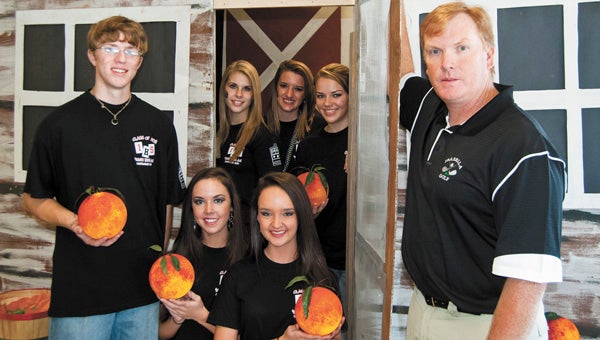Robotics team gets peachy
Published 11:37 pm Friday, October 1, 2010

Senior members of Isabella’s robotics team, along with instructor Jay LeCroy (far right), stand in the Peach Pit store, which will serve as the school’s booth at UAB on Oct. 9. Pictured are (front): Brenden Fletcher, Alissa Higgins, Brianna Baker, LeCroy, (back) Heather Mason, Tori Payne and Holley Thacker.
In its second year of existence, the Isabella High School robotics team is preparing to showcase its talents in a statewide competition at UAB on Oct. 9.
While there, team members will operate a robot that is designed to pick the perfect peach — which explains this year’s theme, “Peachy Keen,” demonstrating both engineering knowhow and a little something about Chilton County.
With the help of volunteers, the team even built a booth that resembles a rural storefront, called “The Peach Pit.”
“It’s kind of like a Cracker Barrel,” said Holley Thacker, member of the senior management team.
Each student fills a different role on the team. Thacker is a head of marketing alongside fellow senior Tori Payne. Brianna Baker is the CEO, Brenden Fletcher the head engineer, Alissa Higgins the vice president, and Heather Mason the head of technical writing.
“My role is to keep all departments in check and make sure that everyone is doing what they’re supposed to be doing,” said Baker.
In a sense, the team is just like a real-world business. They had 41 days to design, build and test a product (the robot) prior to the competition.
“We have to sell this robot,” said Thacker, adding that T-shirts are helping to promote the project.
In order to learn more about the local peach industry, students went to Jimmy Durbin’s packing house and talked to the peach grower about the ins and outs of the business. Jim Pitts, superintendent of the Chilton Research and Extension Center, came to the school as a guest speaker.
As for the engineering side, things can get pretty technical. The team is using a business management strategy known as Six Sigma, first utilized by Motorola in 1981. The basic idea is to identify and remove the causes of defects to achieve a product that is 99.996 percent non-defective.
“The biggest challenge I had was getting a design that would actually work. We tossed around many ideas,” said Fletcher, who plans to study aerospace and mechanical engineering.
Other students have set high goals as well. Baker wants to become a biomedical engineer, and Mason plans on studying graphic design or a similar field at Auburn University. LeCroy said this experience could lead to a four-year scholarship in science, technology, engineering or math.
LeCroy thanked all who had assisted with the project, including Durbin and Pitts, Gay West of the local Extension office, Roger Baker and Gerald Smitherman, and his wife, Nelda LeCroy.






